The new E Series excavators have caused a bit of a stir since they were launched last year, and I have heard many comments whilst out on site about how they look, with some people being less than complimentary about them. But I think one has to look deeper into this. Caterpillar has always been dynamic in its approach and as a company likes to come up with something different than its competitors. The launch of the high drive track system on the D10 in 1977 springs to mind as a very radical step by the American giant, and once again the new E Series excavators have a very different look compared to other manufacturer’s machines. 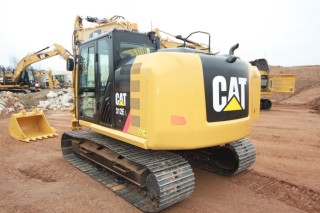
The 312E weighs in at 13.6 tonne and is a direct replacement for the outgoing 312D, it is powered by a 95hp (70kw) Cat C4.4 ACERT electronically controlled diesel engine, as opposed to the C4.2 engine that was fitted to the D Series machines. The 16.7 tonne 316E which replaces the outgoing 315D uses the same engine but is rated at 121hp (89kw). The new engine uses some of the latest technology, including the Cat Electronic Control Module (ECM) and the Cat Clean Emission Module (CEM) to meet the EU stage IIIB emissions standards. As covered in our Malaga Launch post last October, these engines Clean Emission Modules, incorporate a Diesel Oxidation Catalyst (DOC) and a Diesel Particulate Filter (DPF) which perform throughout the working cycle of the machine, cutting down costs for the machine owners without causing disruption or downtime. 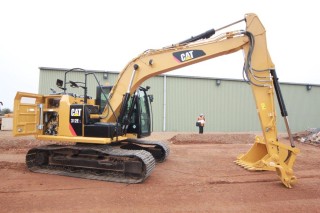
Walking around the new E Series it’s clear to see that routine maintenance has been well catered for. All main service access doors benefit from increased height, and have been constructed lighter but stronger thanks to the new layered steel design. The wider cooling compartment offers an improved oil cooler and engine radiator design that features two cores mounted side by side, with the after cooler and condenser mounted in front. The air cooler can be swung upwards to facilitate cleaning away debris during a regular service. Most filters, including air, engine oil, hydraulic oil and fuel, are accessible from ground level too, further improving regular servicing. 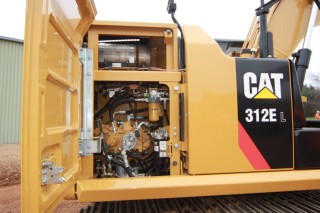
I climbed on board the 312E first for a quick test drive and as one would expect, a large and roomy cab interior greeted me, with most controls, switches and buttons conveniently located to the right of the seat. The joysticks can also be adjusted to suit all sizes of operator by using the graduated height adjustment controls. The seat was comfortable and apparently they can be supplied with heating and cooling options to suit different operating territories. Once I had set myself up in the machine I put it to work. The all new LCD monitor, which is 40% larger than those fitted to the old D Series machines, informed me that the machine was set up in high power mode, which for most operators out in the field is the preferred operating mode. 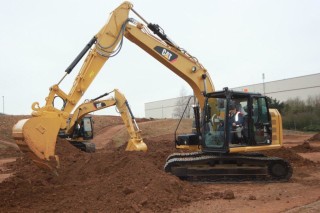
I lifted the boom and the machine roared into life, having said that you would hardly know it was working at maximum throttle as it was incredibly quiet in the cab, and to be honest not much louder outside, which can only be a good thing for personnel working around the machine. I had to set the machine up in front of the hole I was about to excavate as the previous test operator had left it slightly unbalanced causing it to rock about on its tracks. Once adjusted, I put the bucket into the ground and in no time this powerful little machine had a large bucketful which I extracted with speed and precision. 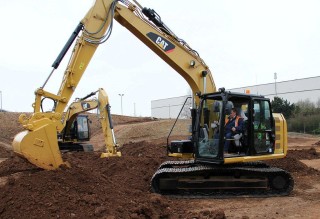

The new profile Cat bucket certainly made for easy digging, I excavated a hole, performed a simulated bund shaping exercise and then backfilled the hole ready for the next test operator. I was totally impressed with the smooth controllability of the hydraulics on these new machines and it would be great to have one on site in real life conditions for a week to really get the feel of the new range, something I may talk to Finning’s about soon. 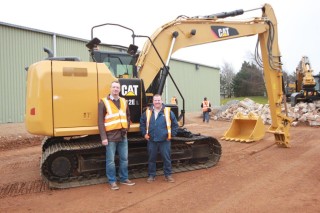
These machines use a Cat Intelligent Hydraulic Control system which manages the engine and hydraulic pump speed, which ensures that the engine is always running at the desired speed regardless of the load, when using the machine one can hear and feel this system in operation, especially when in the dig the engine ramps up to offer maximum power and breakout before ramping back down whilst discharging a bucketful. As well as the usual auto idle function that are common place amongst modern machines, the E Series excavators also have an engine shut-down system which automatically turns the engine off if it has been idling for a pre-determined period of time which can be set by the operator and ranges between 1-60 minutes. 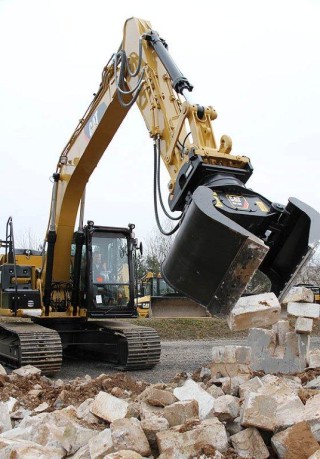
There has been a lot of talk about the large rear end on the New E Series machines, and many have said to me, how can you see anything out of the back when operating them? Well I would say as an operator one would have to adapt your operating style to suit, there is the large rear view camera on the back end of the counterweight and there is provision for a further two cameras to be fitted on either side, the operator can use the large LCD screen to view to the rear and by using the split screen function can view from two different cameras at any one time, add to this the fitment of large rear view mirrors to the left and right of the operator, rear view to all angles should be covered. 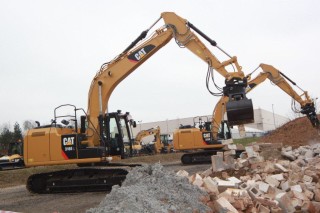
Caterpillar have taken a bold step with the new E Series machines, with so many machines looking the same these days it’s good to see something different coming onto the market place and with Cat quality behind them, it’s almost inevitable they will be well accepted.

